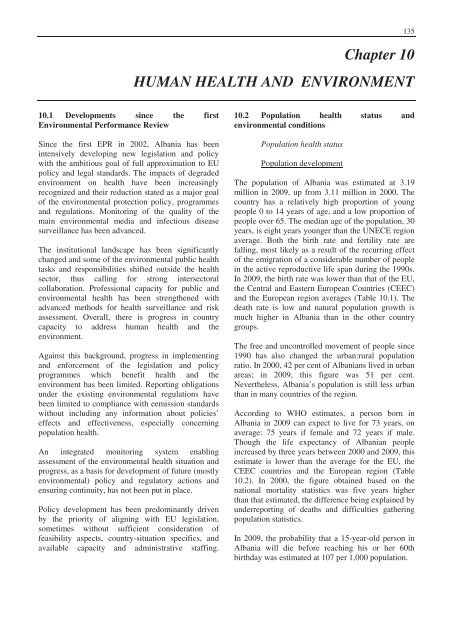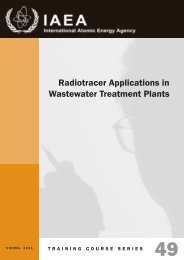Second Environmental Performance Review of Albania
Second Environmental Performance Review of Albania
Second Environmental Performance Review of Albania
Create successful ePaper yourself
Turn your PDF publications into a flip-book with our unique Google optimized e-Paper software.
135Chapter 10HUMAN HEALTH AND ENVIRONMENT10.1 Developments since the first<strong>Environmental</strong> <strong>Performance</strong> <strong>Review</strong>Since the first EPR in 2002, <strong>Albania</strong> has beenintensively developing new legislation and policywith the ambitious goal <strong>of</strong> full approximation to EUpolicy and legal standards. The impacts <strong>of</strong> degradedenvironment on health have been increasinglyrecognized and their reduction stated as a major goal<strong>of</strong> the environmental protection policy, programmesand regulations. Monitoring <strong>of</strong> the quality <strong>of</strong> themain environmental media and infectious diseasesurveillance has been advanced.The institutional landscape has been significantlychanged and some <strong>of</strong> the environmental public healthtasks and responsibilities shifted outside the healthsector, thus calling for strong intersectoralcollaboration. Pr<strong>of</strong>essional capacity for public andenvironmental health has been strengthened withadvanced methods for health surveillance and riskassessment. Overall, there is progress in countrycapacity to address human health and theenvironment.Against this background, progress in implementingand enforcement <strong>of</strong> the legislation and policyprogrammes which benefit health and theenvironment has been limited. Reporting obligationsunder the existing environmental regulations havebeen limited to compliance with eemission standardswithout including any information about policies’effects and effectiveness, especially concerningpopulation health.An integrated monitoring system enablingassessment <strong>of</strong> the environmental health situation andprogress, as a basis for development <strong>of</strong> future (mostlyenvironmental) policy and regulatory actions andensuring continuity, has not been put in place.Policy development has been predominantly drivenby the priority <strong>of</strong> aligning with EU legislation,sometimes without sufficient consideration <strong>of</strong>feasibility aspects, country-situation specifics, andavailable capacity and administrative staffing.10.2 Population health status andenvironmental conditionsPopulation health statusPopulation developmentThe population <strong>of</strong> <strong>Albania</strong> was estimated at 3.19million in 2009, up from 3.11 million in 2000. Thecountry has a relatively high proportion <strong>of</strong> youngpeople 0 to 14 years <strong>of</strong> age, and a low proportion <strong>of</strong>people over 65. The median age <strong>of</strong> the population, 30years, is eight years younger than the UNECE regionaverage. Both the birth rate and fertility rate arefalling, most likely as a result <strong>of</strong> the recurring effect<strong>of</strong> the emigration <strong>of</strong> a considerable number <strong>of</strong> peoplein the active reproductive life span during the 1990s.In 2009, the birth rate was lower than that <strong>of</strong> the EU,the Central and Eastern European Countries (CEEC)and the European region averages (Table 10.1). Thedeath rate is low and natural population growth ismuch higher in <strong>Albania</strong> than in the other countrygroups.The free and uncontrolled movement <strong>of</strong> people since1990 has also changed the urban:rural populationratio. In 2000, 42 per cent <strong>of</strong> <strong>Albania</strong>ns lived in urbanareas; in 2009, this figure was 51 per cent.Nevertheless, <strong>Albania</strong>’s population is still less urbanthan in many countries <strong>of</strong> the region.According to WHO estimates, a person born in<strong>Albania</strong> in 2009 can expect to live for 73 years, onaverage: 75 years if female and 72 years if male.Though the life expectancy <strong>of</strong> <strong>Albania</strong>n peopleincreased by three years between 2000 and 2009, thisestimate is lower than the average for the EU, theCEEC countries and the European region (Table10.2). In 2000, the figure obtained based on thenational mortality statistics was five years higherthan that estimated, the difference being explained byunderreporting <strong>of</strong> deaths and difficulties gatheringpopulation statistics.In 2009, the probability that a 15-year-old person in<strong>Albania</strong> will die before reaching his or her 60thbirthday was estimated at 107 per 1,000 population.
















